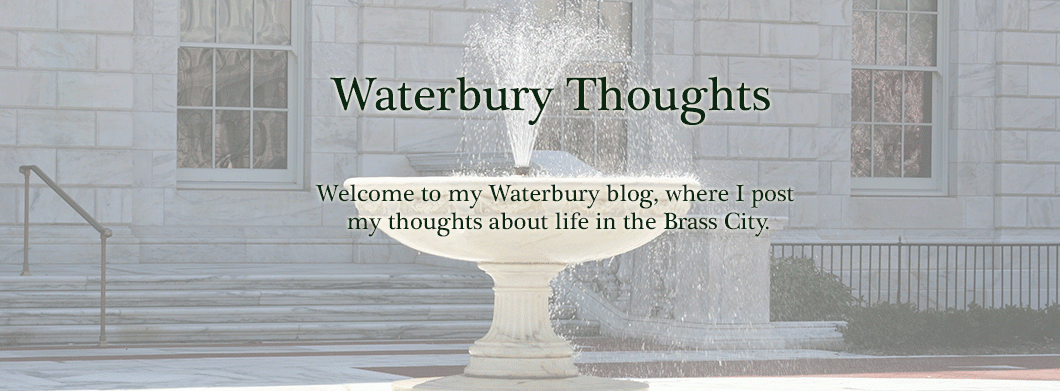
For several years, the building to the east of the Palace Theater on East Main Street has been referred to as the "Rectory Building." I haven't really paid close attention to this name, but every time I heard it, I thought something didn't sound right. In the past week, I heard and seen it called the Rectory Building at least twice, most recently in today's newspaper, and I've finally realized why this naming bothers me: the building is not, and never has been, a rectory. In fact, calling it a rectory does a disservice to the building's rich history. A rectory is the home of the rector, or priest. The building on East Main Street, as far as I know, never served that function.
The building on East Main Street (as seen above in an illustration from Anderson's History of Waterbury, published 1896) is correctly referred to as St. Patrick's Hall. It was built on one of the first property lots to be owned by Waterbury's Roman Catholics, who purchased the site from entrepreneur Elizur Prichard in 1847. Waterbury's first Roman Catholic church (St. Patrick's Chapel--darn typos! the name was St. Peter's, not St. Patrick's--my thanks to Joseph P. Nolan for catching the mistake) stood on the lot from 1847 until 1866. The Chapel was replaced by Waterbury's first Immaculate Conception Church, built on the opposite side of the street (where UConn is today). The old St. Patrick's (St. Peter's!) chapel became a public school, until it was replaced in 1889 with St. Patrick's Hall.
St. Patrick's Hall, Waterbury's best and possibly only [Correction, 2/4/08--there is at least one other, on Bank Street, across from the parking garage] example of the Richardsonian Romanesque style, was built under the leadership of Rev. John A. Mulcahy, an Irish-born priest who came to Waterbury in 1886. The Hall contained the parish's Sunday School, as well as a library and reading room, meeting rooms for Catholic and social organizations, a gymnasium and a large hall for lectures and entertainment. It signaled the emergence of Roman Catholics as respected members of the community--forty years earlier, the parish had struggled to overcome anti-Catholic prejudices in Waterbury.
St. Patrick's Hall is both an architectural gem and an important monument to Waterbury's Catholic history, but it is not a Rectory.

2 comments:
Here's what the same reporter (Steve Gambini) wrote about the origin of the name back in 2004:
Originally called St. Patrick's Hall, the building was built on the site of St. Peter's Church, Waterbury's first Roman Catholic church, as a meeting place for the Total Abstinence Society and the Ancient Order of Hibernians. It also housed a gymnasium on the upper floors.
Its construction was testament to the power the pastor of another Catholic church, the Immaculate Conception, held in Waterbury.
"They (the pastors) were the driving force for the hospitals, the transportation and the social justice and social work issues," said Lawrence F. Duffany Jr., who wrote the 150th anniversary history for the Immaculate Conception Church in 1997.
Immaculate Conception is still known as the "mother church" of Waterbury, not only because of its namesake, but because many of the city's parishes broke off from it as the population grew.
Whoever held the title of pastor at the Immaculate Conception became "kind of the lightning rod person" in the city, Duffany said.
Rectory is the term for a priest's residence, but the name commonly used for the building today may have more to do with the man who built it. The Rev. James Mulcahy, who presided over its construction, was the first priest to hold the title of "permanent rector" of the Immaculate.
Duffany said that honorific likely was the origin of the building's name.
At the time, the building stood across the street from the original church, which later was sold and used as a truck depot for an oil company. It also mirrored the actual rectory for the parish in its placement and architecture. The Immaculate Conception moved to its present location on West Main Street in 1926.
(Republican-American, 3/12/04)
Thank you. I'm a stickler for getting facts right and for having things be logical, so calling a non-rectory building "The Rectory" really drives me nuts!
Post a Comment